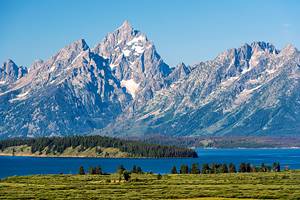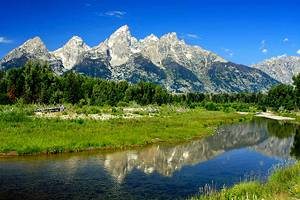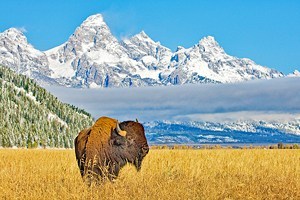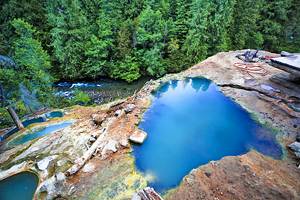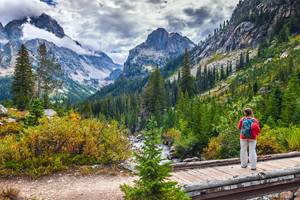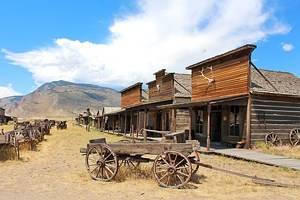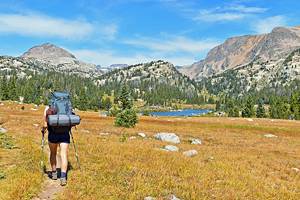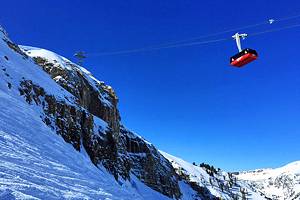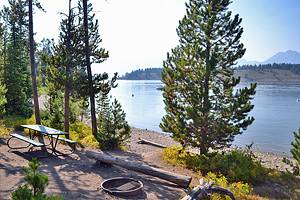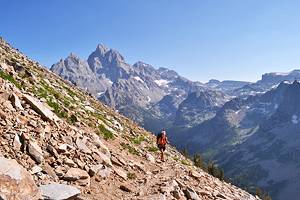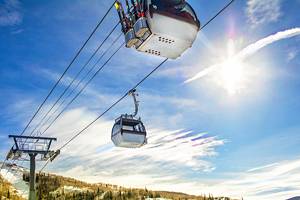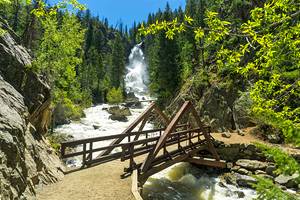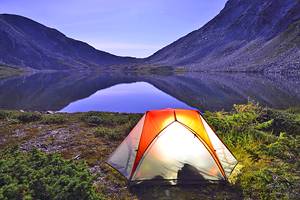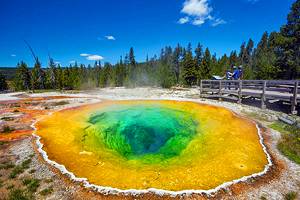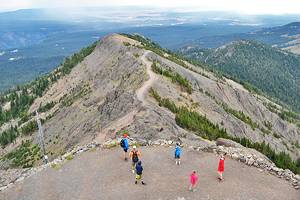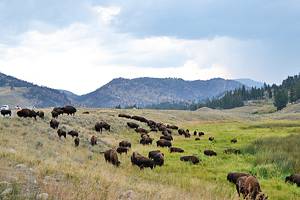Fly Fishing Destinations in Wyoming
Wyoming stars in the fantasies of freshwater fly anglers around the globe. More than 27,000 miles of fishable wild rivers and crystal-clear trout streams slice through this sparsely populated state, and trout lakes sparkle amid soaring peaks and high mountain meadows.

Names like the Snake, the North Platte, and the Green River are legendary among fly anglers for their big fish and beautiful settings. In fact, some of the state's best fisheries lie in the country's most spectacular wilderness areas. Yellowstone National Park holds one of the world's highest concentrations of public lakes and streams, and Grand Teton National Park, the Wind River Range, and the Bighorn Mountains are home to rivers, streams, and lakes brimming with fish.
More than 22 species of gamefish swim in Wyoming's waters, but the state is most famous for its trout, including cutthroat, brook, brown, lake, and rainbow trout. Cutthroat is the only trout native to Wyoming, and if you catch all four native subspecies you can earn a Cutt-Slam certificate from Wyoming Game and Fish Department.
Before you venture out on your fly fishing adventure, note that in Wyoming, anglers on waters that flow through private land must remain in their vessels. Shore fishing or wading is only allowed with permission from the landowner.

Also a word of caution: many of these fishing destinations are in prime bear habitat. Always pack bear spray and stay a safe and respectful distance from wildlife. Finally, for local conditions, Wyoming trout fishing regulations, permits, guided trips, and recommended fly patterns, contact local fly fishing shops in each region.
Given the extensive wilderness waters available to fish, the many ways to enjoy fly fishing in Wyoming from float to wading, and the various weather conditions that impact waters daily and seasonally, it is best to hire a guide who can factor in all of these elements and get you onto the waters that have the best chance of success during your visit.
Find the best places to cast your line with our list of the top fly fishing destinations in Wyoming.
- Yellowstone National Park
- Jackson Hole
- The Wind River Range
- Miracle Mile and the Gray Reef, North Platte River
- Yellowstone River, Upper Clarks Fork
- Pinedale
- Grand Teton National Park
- Tongue River, Bighorn Mountains
- The Big Laramie and Little Laramie
- Flaming Gorge Reservoir
- Bighorn River, Thermopolis
- Two Ocean Creek, Teton Wilderness
- Map of Fly Fishing Destinations in Wyoming
Yellowstone National Park

One of the world's great wilderness areas, Yellowstone National Park is legendary for its fantastic fly fishing in a truly awe-inspiring setting of sprawling meadows, steep canyons, and steaming geysers. Few places in the world offer such a high concentration of public lakes and streams.
The park's geothermal activity raises the alkalinity of the streams nurturing healthy populations of trout and providing prime fishing opportunities. You can cast for seven different varieties of game fish in the park, including cutthroat, brown, brook, rainbow, and lake trout, as well as mountain whitefish and grayling. Only the latter two species and cutthroat are native to the park.
Yellowstone Lake is one of the most popular places to fish in the park with plenty of bank access. You can catch native cutthroat trout along with brook, brown, rainbow, and lake trout. Yellowstone National Park has a program in place to help restore the cutthroat trout populations so anglers are required to take or kill any invasive lake trout that they catch in the lake.

Soda Butte Creek is another prime location to target and a great option for those who are newer to fly fishing because it its wide-open space for long casts. Soda Butte Creek flows through the Lamar Valley so you are surrounded by a vast landscape and free-roaming wildlife.
Seasonal fluctuations impact where the best fishing is in the park in any given season. Anglers keen to fish in the spring should head to the Firehole River for nymph fishing, as it's the first to clear from snow melt - usually in May after Memorial Day weekend.

In early June, the Madison and Gibbon Rivers and Yellowstone Lake are usually ready to fish, and by July, most park waters are clear and fishable. July and August are the prime months, with typically clear weather and frequent hatches. August is also the best time to fish the lakes (Heart Lake is a favorite).
During September and October, the Lamar River and Slough Creek are prime spots as are the Firestone and Madison, when their water temperature drops. October is also great for catching large migrating fish in the Lewis River. Fly fishing in this area of Wyoming in September and October is also when wildlife can be quite active. Keep a keen eye out for bison, especially in the river meadows, as well as both grizzlies and black bears.
Jackson Hole
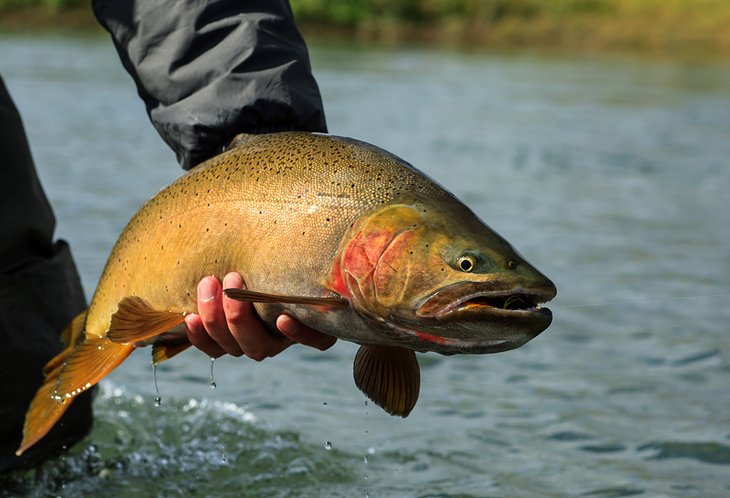
Jackson Hole offers access to some of the most diverse fly fishing opportunities in the United States. True to its name, the Snake River slithers through the valley, offering fantastic fishing nooks with populations of Snake River fine-spotted cutthroat, as well as small numbers of brown trout.
Famous for its large dry fly fishing, the river is the heart of the watershed. It's ideal for fast-paced float fishing but also provides access for wading.
The best times to fish the Snake River are early spring before the runoff and mid-summer through October after the runoff. The Snake River also runs through Grand Teton National Park with plenty of productive water and incredible scenery.
In the National Elk Refuge, two miles north of the town of Jackson, Flat Creek is Wyoming's first fly-fishing-only stream. If you're looking for some DIY fly fishing in Jackson Hole, this is a great spot. It's a challenging creek to fish due to its clear, calm water, but sight fishing is excellent and it can yield big Snake River cutthroat and great dry fly action. Casting is also made easy by the absence of vegetation along the river. This section of Flat Creek opens August 1 through October 31.
Easily accessible from Highway 191, the Hoback River is a great place to cast if you're a beginner, with easy access for wading and a good population of receptive Snake River cutthroat. The Gros Ventre River is also a popular fishing source in the area, also due to its easy accessibility. Unlike the Hoback River, the Gros Ventre lies farther from the road and offers a more peaceful fishing experience.
Other prime areas near Jackson include the Buffalo River, Pacific Creek, and beginner-friendly Granite Creek.
Due to runoff from snowmelt, timing is an important element in planning a fly fishing trip to Jackson Hole. Depending on the area, runoff usually begins around mid-May and continues into the beginning of July.
- Read More: Tourist Attractions in Jackson Hole
The Wind River Range
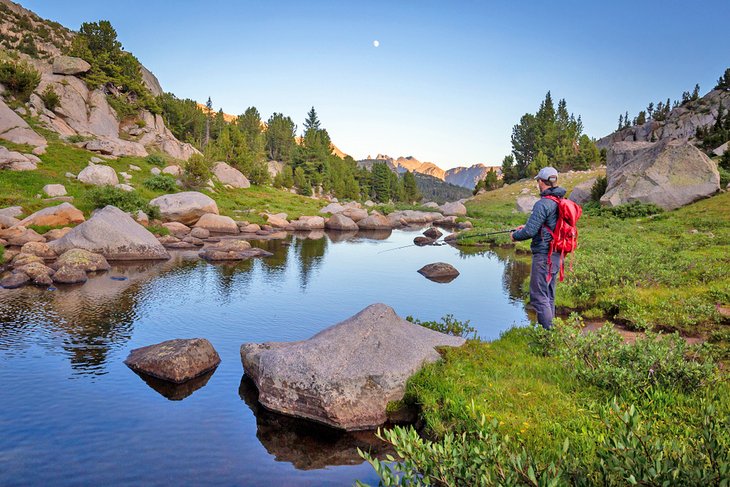
With countless high-elevation lakes, beautiful streams, and wild rivers, the Wind River Range in Western Wyoming offers a rewarding fly fishing adventure in a setting of timeless beauty. Soaring 13,000-foot peaks and abundant wildlife add an edge to fishing in this remote location, and it's a great destination to explore on a backpacking or guided horseback trip.
Fish species found here include cutthroat trout, brook, rainbow, and notoriously big golden trout. Wyoming's record 11-pound golden trout was hooked here at Cook Lakes in 1948. Though this species of fish hasn't been stocked here since the 1990s, they still thrive in certain lakes - especially on the west side of the range.
The east side of the range, from Dubois south to Lander, is less frequently fished and more difficult to access due to the Wind River Indian Reservation, which borders it. You need to purchase a tribal license and hire a tribal guide to access trailheads within the reservation. However, you may be well rewarded for the effort, as the Fitzpatrick Wilderness Area, best accessed over the reservation, has some of the prime lakes with the biggest goldens.
Spring and fall are the best times to fish in this region, although the weather is not reliable at this time of the year. Snow can render some lakes inaccessible until August.
Miracle Mile and the Gray Reef, North Platte River
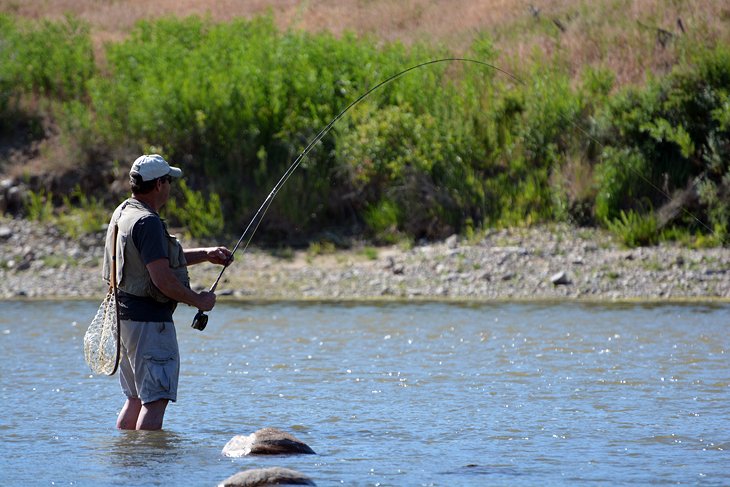
Names like the Miracle Mile and the Gray Reef on the North Platte River are legendary among fly anglers. The North Platte River is a tailwater fishery, so fishing is possible at any time of year, however, fish spawn here, so take care not to disturb the eggs when wading these waters. Rainbow trout spawn during the spring, and brown trout spawn during the fall.
In remote Central Wyoming, about 60 miles from Casper, the easily accessible Miracle Mile section of the North Platte actually extends for five to eight miles and is famous for its fighting trophy trout. Fish thrive in these waters due to the plentiful food, cold water, and relatively low fishing pressure, and the dominant species are rainbow trout, brown trout, and cutthroat.
Miracle Mile is predominantly a nymph fishery, but large streamer patterns are a good choice for luring bigger fish. Dry fly fishing yields success on the right days. Features of the river include pocket water, riffles, runs, and large boulders. River flows can vary dramatically here, so make sure you check conditions before heading out.
Near the town of Alcova, the Gray Reef is a tailwater section of the North Platte River, famous for its huge rainbows, browns, and cutthroats. Fish from eight to 12 pounds are frequently hooked here. Nymph fishing, dry fly fishing, and streamer fishing all yield success. Access can be difficult here due to private land ownership, so floating the river in a drift boat is the best way to fish these waters.
Yellowstone River, Upper Clarks Fork

Catching a native cutthroat trout is a bucket-list achievement for many fly-fishing anglers and the many tributaries like the Upper Clarks Fork that flow from the Yellowstone River are where you can find them. Some of the smaller streams of the Upper Clarks Fork are shallow and wadable as you make your way upstream targeting the seams of fast-moving water and small pools around boulders where the trout like to hide.
More experienced anglers or those with a guide to coach for various techniques can fit into the tight spaces of narrow waters like Dead Indian Creek. The cutthroat trout are small but plentiful here and require stealth movement in the water. Be aware of your shadows that can hover over the pools and spook the fish, especially in the morning sunlight that progressively changes.

The Upper Clarks Fork also features wider spaces like Sunlight Creek where anglers can wade with just wet booties and wading boots in the summer. The open space allows for easier fly casting in the shallow water. Sunlight Creek has many brook trout that are caught with nearly every cast.
To fish the Upper Clarks Fork of the Yellowstone River your best bet is to base in the town of Cody and hire a guide to take you to the sections that are most suitable for the time of your visit. Rainfall and spring snowmelt dramatically impact the water levels and clarity so conditions are always changing. The Upper Clark Fork sections are about an hour's drive into the mountains so you will experience some of the most scenic views in the region.
Pinedale
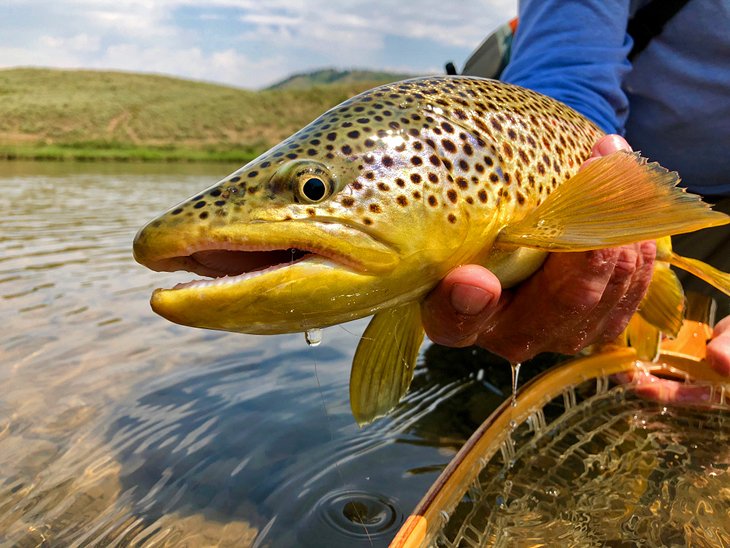
At the foot of the magnificent Wind River Mountains, the little ranching town of Pinedale provides access to some of the state's most hallowed fishing grounds, including the Green River and the New Fork. Both rivers offer excellent drift boat fishing and wading, and you can also cast from the bank.
The Green River, with riffles, runs, pocket water, and pools, is by far the largest of the two rivers. It begins its journey in the northern Wind River Range, and its upper reaches lie in the Bridger-Teton National Forest. Outside of this area, much of the river flows through private land, so it's important to check for public access. You'll find eight miles of public access just upstream from Warren Bridge on Highway 187, north of Daniel.
The New Fork flows from New Fork Lakes to the Green River and is well suited to more experienced anglers. Fish species found in the Pinedale area include native Colorado cutthroat and mountain whitefish, as well as brown, golden, rainbow, brook, and lake trout.
Fishing season on the Green usually begins around mid-June. Trips into the west side of the rugged and beautiful Wind River Range also leave from Pinedale.
Grand Teton National Park
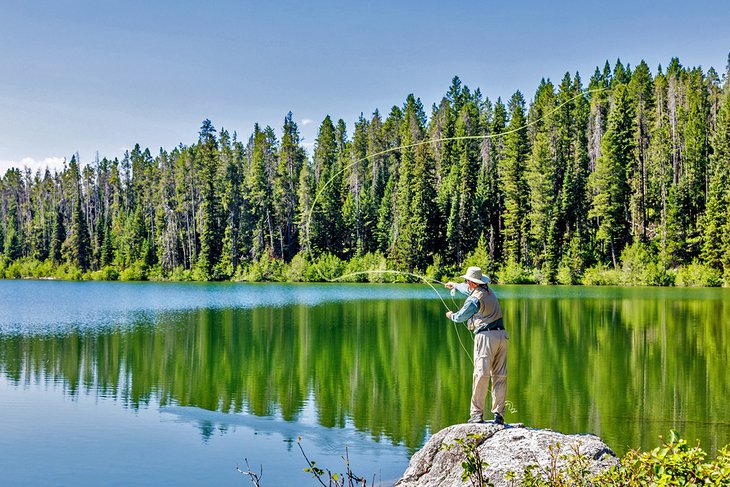
Crowned by the jagged peaks of the Teton Mountain Range, Grand Teton National Park, about 10 minutes from the town of Jackson, offers one of the most spectacular settings for fly fishing in the country. The Snake River flows through the park, offering plenty of bends and banks for shore fishing and a breathtaking drift boat experience.
Also within the park, Jenny Lake offers easy access for anglers and more stunning scenery. You can fish for both cutthroat and lake trout from the banks on the hiking trail that rings the lake, or launch a boat from the ramp on the lake's south side. The best time to fish this lake is after the ice melts, which typically occurs around mid-May.
Jackson Lake also offers decent fly fishing for lake trout and mackinaw after the ice melts in the spring, before the water warms up and the fish swim deeper. Fishing from shore can be successful at this time, as the fish swim the shallow waters in search of baitfish. A state record 50-pound mackinaw was caught here. From mid-September when the water temperatures start to drop, the lake trout begin to spawn, and the lake is closed during October to protect spawning Mackinaws.
Fly fishing for cutthroat and lake trout in Leigh Lake is best done from a canoe since the lake lacks shore access. You can paddle from String Lake to the portage point, then carry the canoe the short distance to Leigh Lake. The ice typically melts here around mid-May. Anglers will also find a couple of productive streams to fish within the park's borders.
Official site: http://www.nps.gov/grte/planyourvisit/fish.htm
Tongue River, Bighorn Mountains
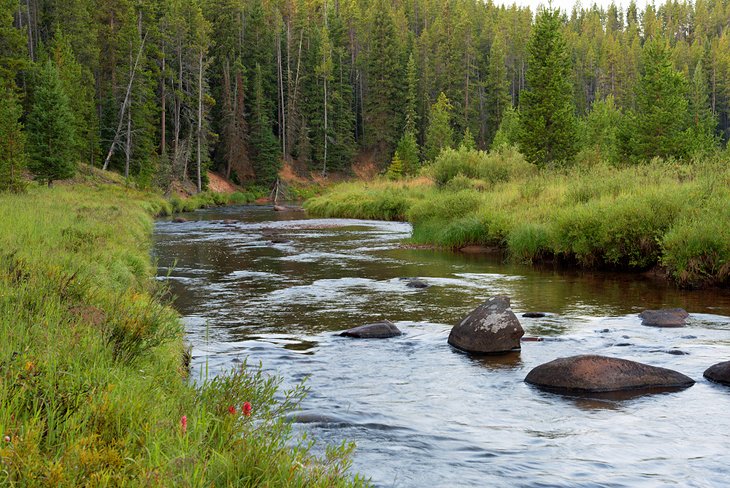
High in the Bighorn Mountains of north-central Wyoming, the Tongue River is a tributary of the Yellowstone River. Steeped in Native American history, it's often overlooked by anglers but yields fantastic fishing for all abilities in a beautiful setting.
The river starts in the Bighorn National Forest, west of Sheridan, and was named for a distinctive rock formation that the Crow Indians thought resembled the tongue of a bison. You can access most of the fishing spots from the Bighorn Scenic Byway. In the South Tongue, fish species are mostly small rainbows, browns, and brook trout, and the latter can be kept for the frying pan.
Fly fishing in the Bighorn Mountains can be excellent. The clear waters here feature pocket water, runs, and pools, and they're a great place for less experienced anglers. The fertile North Tongue waters yield much bigger fish, including cutthroats up to 20 inches, as well as rainbows, brown, and brook trout, but they are more challenging to hook.
Above the mouth of Bull Creek, all trout except brook trout are strictly catch-and-release. Accessible only on foot along rugged boulder-strewn trails, the section of the river that cuts through the steep-walled canyon serves up stunning scenery and supports healthy populations of rainbow and brown trout, as well as cutthroats.
Hiking deep into the canyon leads to some rarely-fished nooks in peaceful surroundings. The best time to fish the Tongue River is after the runoff ends, usually in early July, as well as early fall.
The Big Laramie and Little Laramie
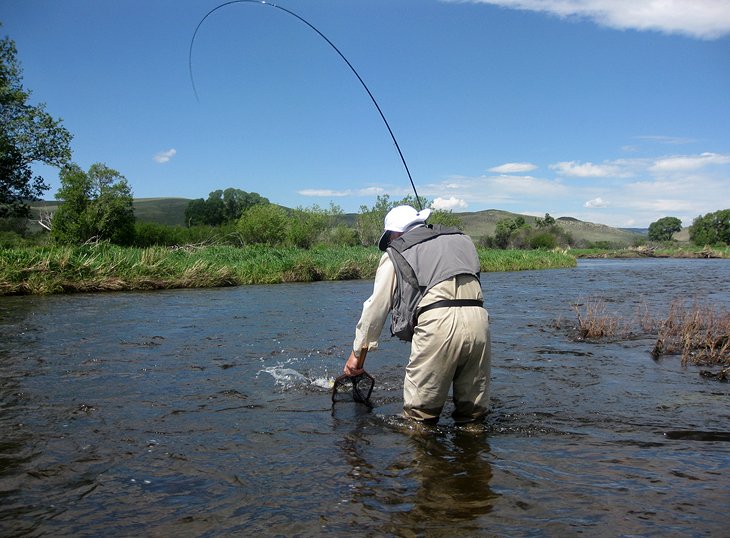
In southeastern Wyoming, the Big Laramie River is known for its excellent wild brown trout fishing, but sections of the river are also stocked with rainbow trout.
The most beautiful stretch of the Big Laramie River that's accessible to the public is the Jelm Access, 30 miles west of Laramie off Wyoming State Highway 230, then south on Wyoming State Highway 10 (near Woods Landing). This section of the river runs through a relatively small canyon with faster water, overhanging banks, and pocket water. Wading is the best way to fish these waters, and the best time is from mid-May to the beginning of July and in the fall.
The Little Laramie River can yield trophy trout, but they are far more challenging to catch. Stalking the fish is often required along this stretch. Access can also be a little more difficult due to the surrounding stretches of private land. Make sure you request permission from landowners or hire a private guide.
Flaming Gorge Reservoir
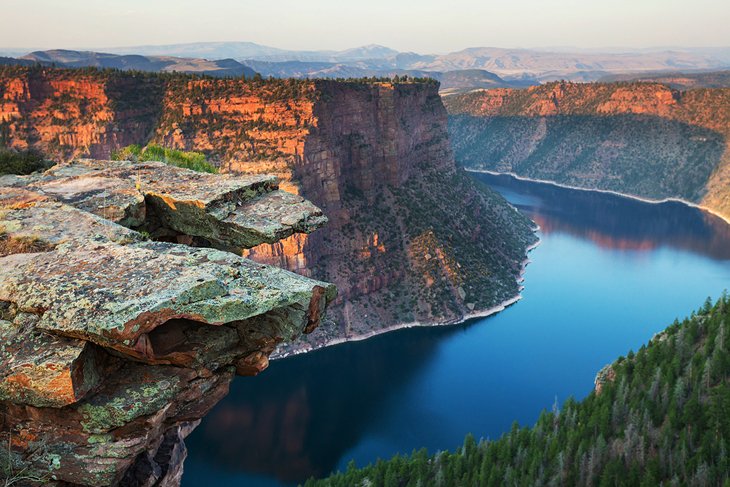
Stretching south from the town of Green River and slicing through the border between Wyoming and Utah, Flaming Gorge Reservoir offers a diversity of species and is known for its big fish.
The Green River feeds these waters, which flow through a steep red-walled canyon and are home to species such as Mackinaw trout, rainbow trout, tiger trout, channel catfish, Kokanee salmon, carp, burbot, and smallmouth bass. World record German brown trout were caught here in the 70s and 80s, as well as state record lake trout, brown trout, and rainbow trout. Today, trout in excess of 20 pounds are still hooked.
Early spring is the best time to fish for trout species and salmon, while bass are more active in the summer when the water is warmer. You can sight cast for carp in shallow water usually from June. Access to the reservoir is through Green River on Highway 530 or the town of Rock Springs on Highway 191. Both boat and shore fishing are possible here.
Bighorn River, Thermopolis
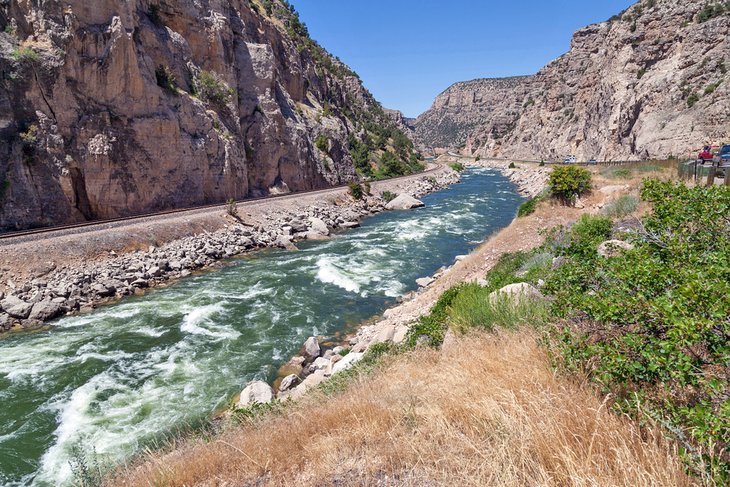
The little town of Thermopolis is best known for its mineral pools at Hot Springs State Park, one of the top attractions in Wyoming, but it's also a top spot for fishing. Officially the Wind River becomes the Bighorn River at the "Wedding of the Waters," and only about 20 miles downstream of this offers water cool enough to support trout year-round.
Serenity, solitude, and a high density of large fish are the top draws at this remote tailwater of the Bighorn River, and anglers have the chance to hook rainbow, brown, and cutthroat trout here.
The Bighorn is open for fishing year-round and is excellent for dry-fly, nymph, and streamer fishing. March through July are the prime times, with heavy hatches and excellent dry-fly action. Fall fishing is also good.
Access to the river is made easy by the fact that the municipality owns most of the Bighorn River around Thermopolis, so you can wade upstream or downstream from public access points to cast your line, as long as you stay below the high-water mark. You can also float the river, but check with locals for details and dangers before you set out.
Two Ocean Creek, Teton Wilderness
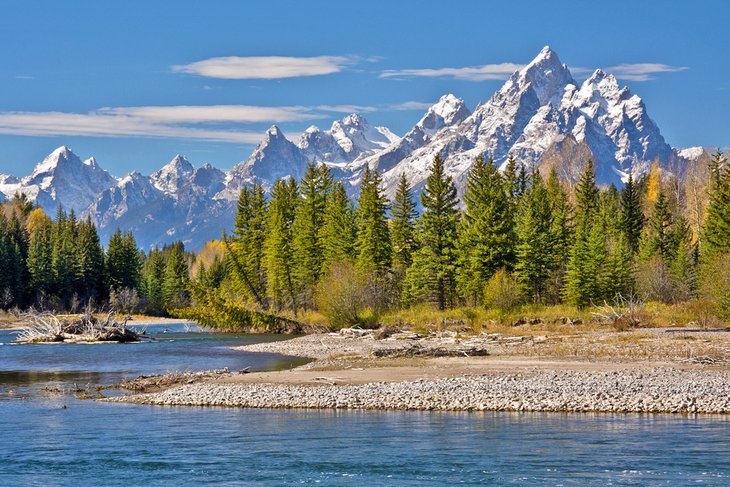
Adjacent to the south end of Yellowstone National Park, Teton Wilderness encompasses more than a half million acres and is home to a fascinating phenomenon found nowhere else on the continent. Along the Continental Divide here, the famous Two Ocean Creek forks and flows to two different oceans: the Atlantic and Pacific.
The first creek, appropriately called Atlantic Creek, flows into the Yellowstone River and on to the Atlantic Ocean, while Pacific Creek flows into the Snake River and eventually feeds into the Pacific Ocean. More than 450 miles of trails lead to fantastic fishing areas and beautiful plateau country featuring lodgepole forests and sprawling meadows.
This is prime cutthroat country. In early summer, they migrate from Yellowstone Lake up the Yellowstone River to spawn in the Teton Wilderness. Thorofare Creek is particularly good for cutthroat fishing, but you can also cast a line to them in some of the tributaries. Keep an eye out for grizzlies in this area and always carry bear spray.
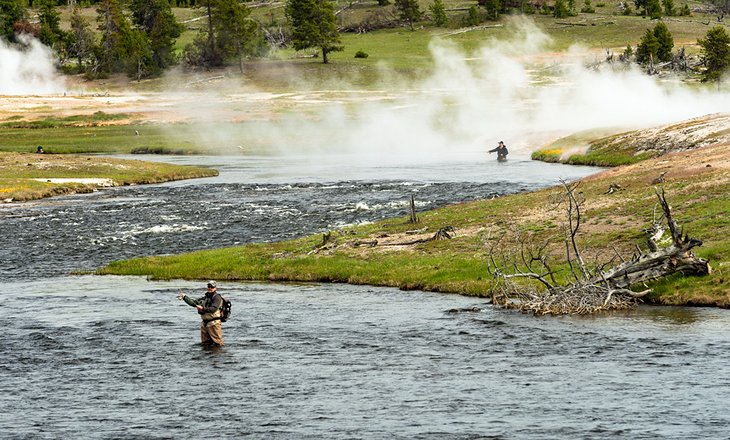
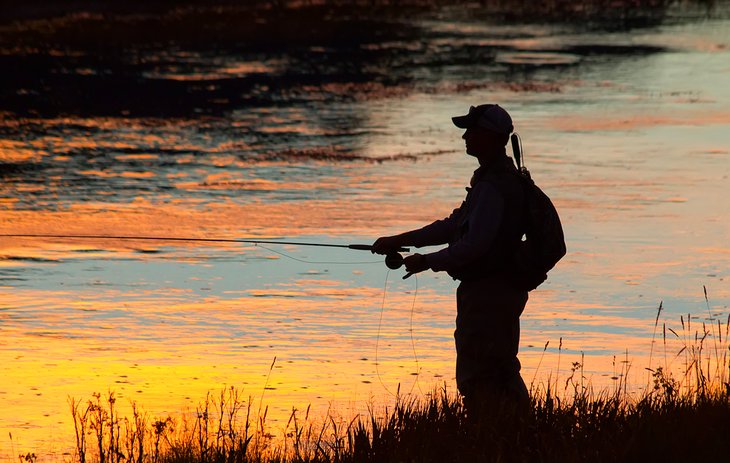
Map of Fly Fishing Destinations in Wyoming
More Related Articles on PlanetWare.com
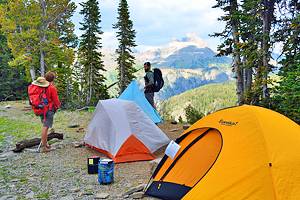
Where to Camp in Wyoming: Staying in Wyoming fly fishing lodges can be a relaxing experience after a day of fishing. But sleeping under the stars in the wilderness can be magical. For details on the best camping locations, see our articles on the top campgrounds at Grand Teton National Park and Yellowstone National Park. And if you're traveling elsewhere in the state, plan your travels with our list of the best places to camp in Wyoming.


